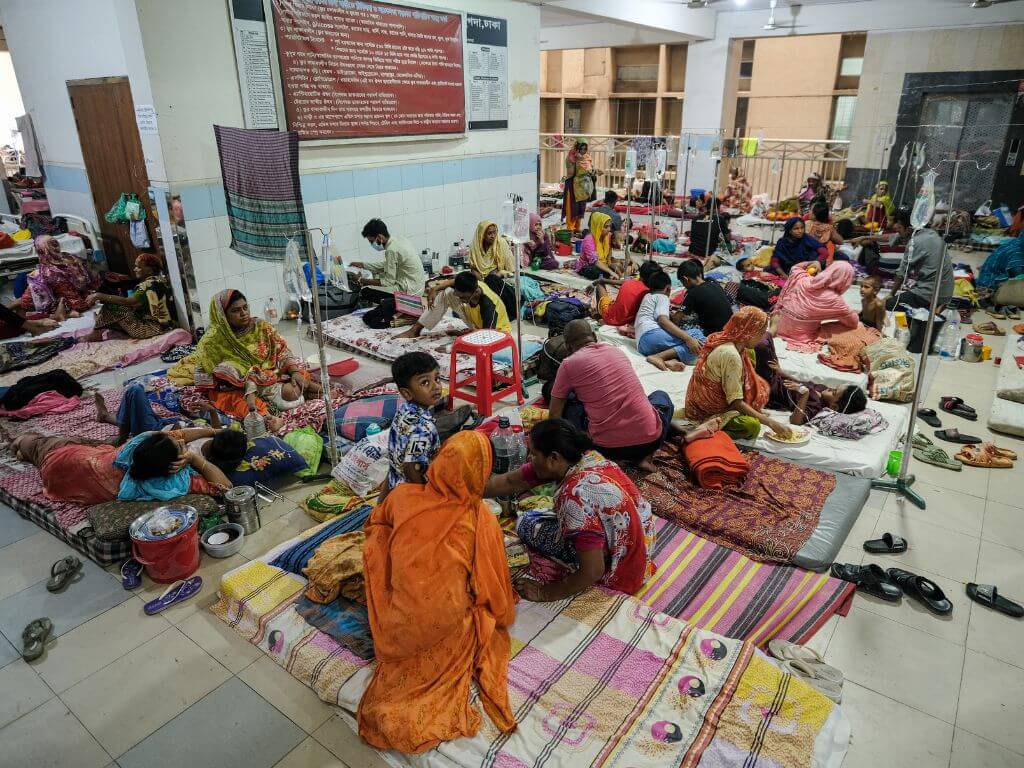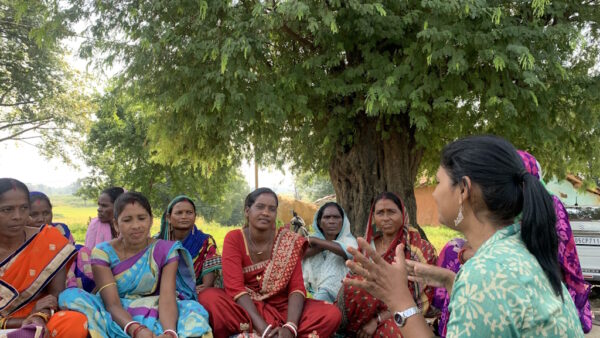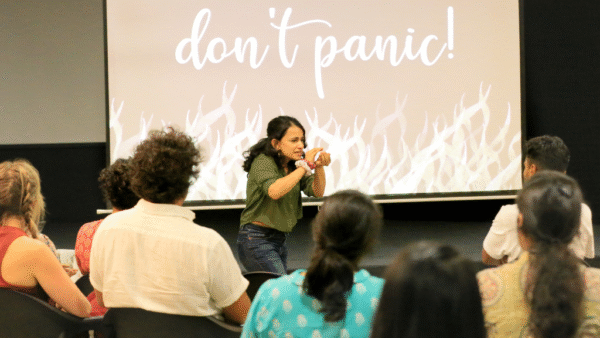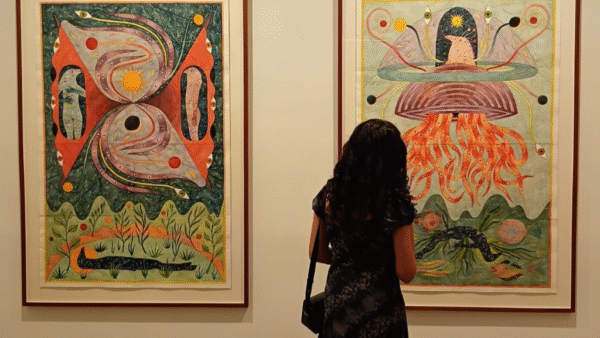The scene at the Dhaka Medical College Hospital (DMCH), Bangladesh’s prime tertiary-level healthcare centre, would rival a battleground. Despite the capacity expansion from 1,700 beds ten years ago to 2,600 now, there is an unmistakable sense of overwhelm here. The hospital is packed to its gills with patients flowing in as Bangladesh has witnessed the deadliest dengue outbreak in 2023 – 2,73,078 cases and 1,355 deaths till 01 November[1] with a sharp surge of cases in August-September. The rise in vector-borne disease has been linked to climate impact.
The eighth floor of the hospital for women patients was so over-crowded in the third week of August that the authorities had to turn the hospital atrium into a large makeshift ward and assign patients to floor beds. Here, on a floor bed, lay 16-year-old Lamiya with her mother, Selina Akter, serving a frugal evening meal. Lamiya was first diagnosed with dengue on August 11 and her parents preferred to keep her at home with medicines from a local pharmacy. When her blood platelets dropped below 50,000 after about a week, the teen was rushed to DMCH. In only two days, her condition improved. She wanted to be discharged – the floor bed was hardly comfortable, there was literally a crowd around, and many male attendants.
There was another reason too. “In two days, half of my father’s monthly salary has been spent,” a weak Lamiya told me. Her father Abdul Matin earns Tk 14,000 [$125] a month at a bicycle shop. The family lives in a rented house in the congested Noor Box Lane in Old Dhaka, that’s a narrow alley often overflowing with sewage water where vector-borne diseases are rampant and anti-mosquito drives are irregular. When Lamiya’s condition deteriorated, Matin approached the Sir Salimullah Medical College Hospital, the tertiary-level hospital 500 metres from his house but it did not have a bed. Then the DMCH was his only hope because he could not afford private healthcare.

Photo: Saqlain Rizve
On paper, treatment at DMCH is almost free of cost – a patient is admitted for only Tk10 [$0.091] – but the cost of all medicines has to be borne if the patient is not accommodated in the hospital’s 2,600-bed capacity, as in all public hospitals here. Lamiya, as a ‘surplus’ patient, had to buy medicines and injectable saline from private pharmacies at inflated prices. During every health crisis, retail prices of emergency medicines shoot up.[2] Even the green coconut, a natural source of minerals and nutrition for dengue patients, becomes costlier, as the Directorate of National Consumer Rights Protection identified.[3]
Money is not a factor for Mohammad Eyaqub (name changed), a well-established businessman of Old Dhaka. Referred from a specialised private hospital, his wife, a dengue patient, was admitted to DMCH on August 16. He managed a bed and fluids for his wife after a bakshish (gift, euphemism for bribe) to hospital employees. At DMCH, the price of a dengue test is Tk50 but the long queues were off-putting for the couple, so he got it done from a private diagnostic centre where it costs Tk500; the report was delivered to her bed. The government had fixed Tk300 for a dengue test at private diagnostic centres but they frequently over-charge. With his wife out of danger in only three days, he could get her discharged from the hospital and treated at home.
The two stories show how unequal healthcare is in Dhaka, Bangladesh’s capital city. Such inequality increases the burden on the poor, and as it often happens, women nurse their dear ones at the cost of their own health to save a few precious pennies. These consequences are harsher when Climate Change brings about conditions such as heat waves and flash floods which intensify vector-borne diseases across the densely-populated city.
Between January 1 and August 30 this year, at least 1.21 lakh people were diagnosed with dengue in Bangladesh with nearly half of them – 57,146 – only in Dhaka. Although men dominate the number of hospitalised patients at 62.2 percent, the fatality rate for women is higher at 58 percent, according to the Directorate General of Health Services (DGHS).[4] Health Minister Zahid Maleque admitted[5] that the delayed hospital attention for women, resulting in delayed treatment, may be responsible for higher mortality rate from dengue. The health impact of Climate Change here has a rarely-recognised gender angle.

Photo: Sadiqur Rahman
Climate Change and Dhaka’s dengue
Dhaka is one of the fastest-growing as well as the poorest megacities in the world, grappling with many public health-threatening problems such as pollution, unregulated construction work, and vehicles that are unfit to be on the streets. Moreover, continuous and unplanned rural-to-urban migration tends to generate new health risks. Such risks become severe with the inevitable impacts of Climate Change.
A World Bank study[6] finds that Climate Change, unplanned rapid urbanisation, high population densities, insufficient preparedness, including inadequate public health infrastructure and weak vector-control programmes, are factors that contribute to the magnitude and severity of dengue outbreaks in Bangladesh.
Analysing the changing weather patterns and dengue infection rates between 2000 and 2019, the study asserts that the climate was more conducive to mosquito breeding and disease transmission in Dhaka than in other areas.
Another study[7] published in May this year predicts that the number of dengue cases will increase 1.13 times if the maximum temperature increases by 1 degree Celsius.
This is among the surest link between climate-related extreme weather and the outbreak of vector-borne diseases like dengue. The poor pay the price, literally and figuratively.
Poor patients pay more than the rich
A 2019 study[8] showed that the poorest families living in Dhaka city pay approximately 33 percent of their household income for healthcare while the richest only spend 5.2 percent. It also showed that the poor often cannot afford healthcare due to high treatment costs. Further, the study asserted that the wealthiest households use their regular income and savings for healthcare while poor people suffer in coping with treatment costs, sometimes borrowing from local money-lenders at high interest rates.
At Dhaka Children Hospital’s dengue ward, on August 20, a weak six-year-old Marium lay recovering from dengue. Her mother Shahida, tending to her, looked tired. Little Marium, from the unplanned urbanised Anandanagar area of Mirpur, suffered from high fever for a week. Shahida initially used paracetamol at home but eventually brought the child to a nearby clinic where dengue was detected. The family then came to the government-run Children’s Hospital. As its stock of injectable saline and medicines dwindled due to ‘surplus’ patients, Marium’s rickshaw-puller father Yusuf was forced to purchase privately. “In four days, we spent Tk10,000 on her treatment. Her father’s monthly income does not exceed Tk15,000. He has already borrowed for other expenses,” said Shahida.
Patients in private hospitals or clinics spend significantly more than those who used public facilities, the study showed. But as a proportion of their income, the poor who used public facilities also spent more. People’s out-of-pocket (OOP) payment costs are significantly associated with their healthcare expenses. Any payment related to medical fees, purchases of medicines (prescribed or not), user fees for care and payments for equipment and diagnostic tests are included as OOP.

Photo: Saqlain Rizve
Mohammad Mintu, a 52-year-old small businessman in the densely populated Jurain area – Dengue Red Zone[9] – experienced the difference between private and public hospitals. His family lives in the Fazil Sardar Pukur Par area which was a large pond 20 years ago. However, there is now no space left for rainwater retention. In every monsoon, the area as well as the ground floors of the congested multi-storey buildings are submerged due to clogged drains, breeding diseases.
Afraid of high and excessive costs, many migrants to urban slums are reluctant to access hospital or clinic services, but they hardly escape infectious diseases. The BIDS study found that people who shared accommodation, such as sublets or tenants, spend significantly more than self-owned households on healthcare expenses; the tenants are usually poor, and have a longer treatment period necessitating higher expenditure, researcher Abdur Razzaque Sarker explained.
Arjina Begum, 33, a housemaid, lives with her two sisters in Basabo which is another Dengue Red Zone.[10] Their house is an urban slum room – a barrack-style congested accommodation facility usually occupied by lower-income families. On July 14, Arjina was diagnosed with dengue but stayed back at home. Ten days later, her younger sister Aasia Begum, garment factory worker, was admitted to the dengue ward of the Mugda General Hospital. Unwell herself, Arjina attended to her ailing sister at the hospital. Meanwhile, their elder sister Marjina and her eight-year-old daughter, Soma Akter, were also detected with dengue. The sisters Arjina and Marjina were on floor beds in the 500-bed Mugda Hospital. “Combined, our monthly income is around Tk60,000. In one month, we have spent around Tk 1 lakh for four of us,” said Marjina’s husband Jakir, a government office peon.
In Bangladesh, an average 69 percent of the healthcare expenses is borne by patients themselves; only people with means can access proper medical treatment. “If you have less, you will need to either borrow money to cover up the deficits or sacrifice health. This is the real fact,” said Sarker, Research Fellow (Health Economics) at BIDS, “My experience suggests that the OOP payment now has certainly gone high after the Covid pandemic because of rising inflation and income inequality.”

Photo: Sadiqur Rahman
Women fall through the cracks
Living in urban areas, it is presumed, offers opportunities including access to better healthcare; Dhaka has a number of health centres too. However, the city’s healthcare fails not only its poor but also women from poorer communities. Housing 17 specialised public hospitals,[11] eight tertiary-level hospitals, three 500-bed public hospitals, and 10 different capacity hospitals, besides 651 registered private hospitals,[12] Dhaka has a lot to offer in healthcare – but at a price.
Although there is no data available about the number of people at private hospitals, the Health Bulletin 2020[13] estimated that at least 17,58,967 women patients received outdoor medical services at 13 Dhaka-based public hospitals surveyed in 2019 while the number of women admitted as patients were only 5.49 percent of the outdoor patients.
Earlier in 2015, a Planning Ministry’s monitoring report[14] identified the reasons behind women’s discomfort in public hospitals. It found that the hospitals did not have all the characteristics of women-friendly hospitals. “The reasons for not establishing the women-friendly hospitals are absence of protocol, inadequate training, frequent change of manpower, less privacy for women and so on,” the report says.
Professor Dr Sharmeen Yasmeen, former chairperson of Public Health Foundation Bangladesh, and currently Head of the Department of Public Health and Community Medicine, Bangladesh Medical College, Dhaka, observes that the existing patriarchal society is not ready to listen to physical problems of a woman. “Inaccessibility to proper healthcare sometimes deteriorates an ailing woman’s health condition to the point from which recovery becomes very difficult. This happens even in many educated families,” Yasmeen told me, “Women have to raise their voices.”
She estimates that the death rate is higher for women dengue patients and wants the Health Ministry to conduct a death review to understand the social and economic conditions of the dead women. “Maybe we will see that in most of them, the disease was not diagnosed before their death.” Urban poor women do household chores and their informal jobs as well, hiding their illness so that their day jobs are not interrupted; besides, they tend to limit out-of-pocket payments for their healthcare.
The Ministry of Health and Family Welfare has recently taken up a Tk 2,90,370 crore-worth healthcare improvement programme which promises, among other things, a drop in people’s out-of-pocket healthcare expenses by 29 percent.[15] If this comes to pass, the gap in healthcare between the poor and well-off people would begin to close.
Sadiqur Rahman, a post-graduate of the University of Dhaka, is currently employed as a journalist in The Business Standard. His 10-plus-year career in journalism includes reporting on Climate Change, biodiversity conservation, local business, and livelihood-related issues. A member of the Thomson Reuters Foundation Alumni Club, Bangladesh, he won two anti-corruption media awards in 2014.
This is the second part of a series supported by the QoC-CANSA Fellowship to report on Climate Change and cities in four nations of South Asia. The first part can be read here.
Cover photo: Mugda General Hospital by Saqlain Rizve




